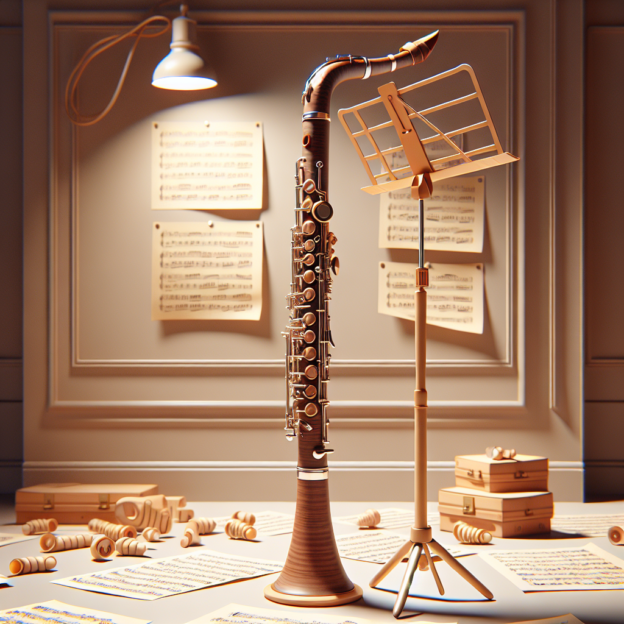The Science Behind Clarinet Acoustics: Where Physics Meets Music
Have you ever wondered how the clarinet creates its beautiful, soulful sounds? The science behind historical clarinet acoustics research shows us how physics and artistry come together. Understanding what happens behind the scenes can deepen your appreciation for this incredible instrument!
The Evolution of the Clarinet
The clarinet we know today has changed a lot since its early days in the 18th century. Originally made from wood, its design and shape have changed dramatically over time. Companies like Martin Freres have shown how skilled makers have adapted to musicians' changing needs.
| Time Period | Material | Key Features |
|---|---|---|
| 18th Century | Wood (Boxwood) | Simple key system, limited range |
| 19th Century | African Blackwood | Boehm system introduced, improved intonation |
| 20th Century | Grenadilla, Plastic | Refined key work, experimentation with materials |
| 21st Century | Grenadilla, Synthetic materials | Advanced manufacturing, custom designs |
Modern Clarinet Materials and Acoustics
Today's clarinets are often made using various woods such as grenadilla, which offers robust sound and durability. The choice of material significantly affects the instrument's timbre and resonance. Have you sometimes noticed that your clarinet sounds different in various settings? That's all tied to its acoustics! Factors like temperature, humidity, and even the venue's size play a role in how sound travels and resonates.
Clarinet Construction and Sound Production
Looking into historical clarinet acoustics also involves studying how the keys and bore construction influence sound production. The bore is the internal shape of the clarinet – a key element in determining the tone quality. Clarinetists often adjust their technique based on subtle changes in bore shape. This interaction between design and personal style creates an even richer sound.
Pushing Sound Boundaries in Modern Clarinet Design
Musicians today are always trying new things to expand what's possible with sound. Some even look for custom clarinet designs to find their ideal sound. Companies like Martin Freres are valuable here – they're dedicated to making instruments that work for both traditional and new playing styles. For a new clarinetist or experienced player, picking a clarinet that fits your unique style can really make a difference.
The Role of Mouthpieces and Reeds
Another interesting area in clarinet acoustics research is how mouthpieces and reeds affect a musician's ability to express themselves. The mouthpiece is often a player's direct connection with the instrument. A well-made mouthpiece can improve response and articulation, helping musicians convey emotion and clarity in their performance.
Technology Meets Tradition in Clarinet Playing
Let's talk about something different for a moment. Have you heard about musicians using built-in electronics and digital technology? As everything around us changes quickly, it's not surprising that some clarinetists are using tech to expand their range of sounds. Imagine that – mixing old traditions with new technology! Sounds pretty exciting, doesn't it?
The Physics of Sound Waves in Clarinets
Historical acoustics research helps us understand how sound waves work and interact. A sound wave moves through the clarinet body, creating vibrations in the air. This is what allows for the complex harmonics that make beautiful melodies. It's amazing to think about how physics and art work together so well, isn't it?
Learning More About Clarinet Acoustics
To really get what clarinet acoustics research is all about, you might want to go to workshops or programs that focus on understanding acoustics. Many orchestra players and teachers think this is important, encouraging students and fans to learn more about the science behind sound.
Taking Care of Your Clarinet
Don't forget how important it is to take care of your instrument. Keeping your clarinet in good shape not only makes it last longer but also helps it sound its best. Regular cleaning and proper care can directly affect how well it plays, helping you in all your musical activities.
Wrapping Up: The Impact of Clarinet Acoustics
Understanding the long history of clarinet acoustics can change how you think about music. Learning about how the instrument has changed, how different materials affect it, and what makes each clarinet special opens up a whole new world. So, take a closer look at that clarinet—you might just find yourself fascinated by the science that makes music so powerful!
Table of Contents
- The Science Behind Clarinet Acoustics: Where Physics Meets Music
- The Evolution of the Clarinet
- Modern Clarinet Materials and Acoustics
- Clarinet Construction and Sound Production
- Pushing Sound Boundaries in Modern Clarinet Design
- The Role of Mouthpieces and Reeds
- Technology Meets Tradition in Clarinet Playing
- The Physics of Sound Waves in Clarinets
- Learning More About Clarinet Acoustics
- Taking Care of Your Clarinet
- Wrapping Up: The Impact of Clarinet Acoustics







